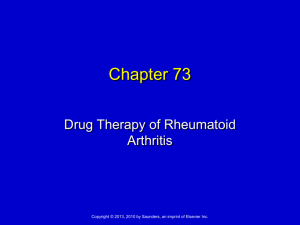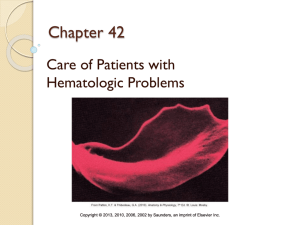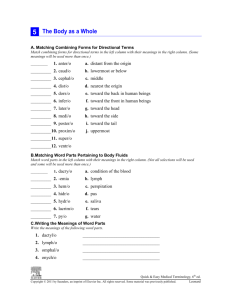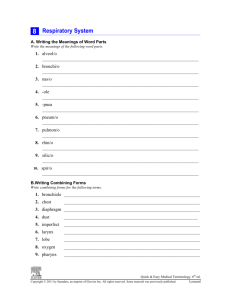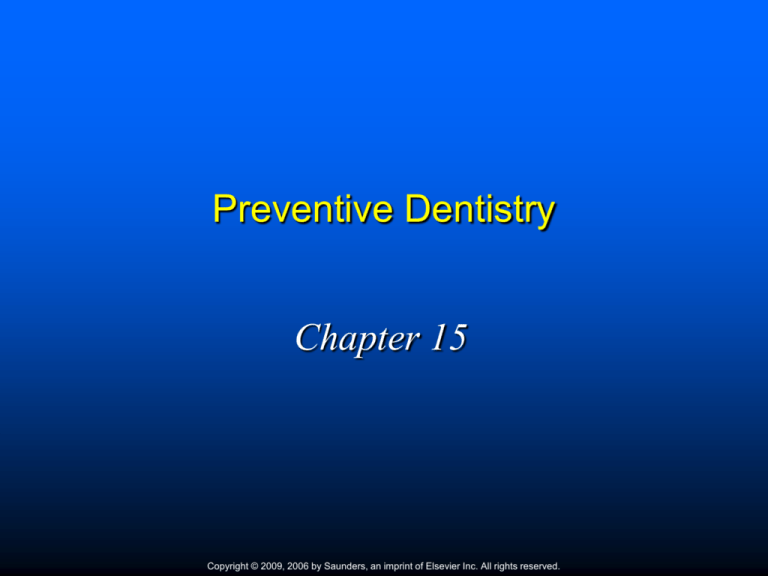
Preventive Dentistry
Chapter 15
Copyright © 2009, 2006 by Saunders, an imprint of Elsevier Inc. All rights reserved.
Chapter 15
Lesson 15.1
Copyright © 2009, 2006 by Saunders, an imprint of Elsevier Inc. All rights reserved.
Learning Objectives
Pronounce, define, and spell the Key
Terms.
Explain the goal of preventive dentistry.
Describe the components of a program of
preventive dentistry.
Assist patients in understanding the
benefits of preventive dentistry.
Copyright © 2009, 2006 by Saunders, an imprint of Elsevier Inc. All rights reserved.
Introduction
The goal of preventive dentistry is to
have a healthy mouth for a lifetime.
To achieve this goal, new and recurring
disease must be prevented.
Copyright © 2009, 2006 by Saunders, an imprint of Elsevier Inc. All rights reserved.
What Is Preventive Dentistry?
Patient education
Fluorides
Dental sealants
Proper nutrition
Plaque-control program
Optimum oral health can become a reality.
Copyright © 2009, 2006 by Saunders, an imprint of Elsevier Inc. All rights reserved.
Guides for Patient Education
Listen carefully: Each patient will have
different needs.
The initial instruction: Explain the relationship
of plaque to dental disease.
Assess the patient’s motivations and needs:
Combine the patient’s motivating factors with
the patient’s needs.
Select the home cleaning aids: Select a toothbrush,
toothbrushing method, interproximal cleaning aids
such as dental floss, and a toothpaste.
Keep the instruction simple: Comment positively
on the patient’s efforts.
Copyright © 2009, 2006 by Saunders, an imprint of Elsevier Inc. All rights reserved.
Fig. 15-1 The mother lifts the child’s lip and
looks for early signs of decay.
Copyright © 2009, 2006 by Saunders, an imprint of Elsevier Inc. All rights reserved.
Fig. 15-2 The dental assistant uses the intraoral camera to aid
patient education.
Copyright © 2009, 2006 by Saunders, an imprint of Elsevier Inc. All rights reserved.
Chapter 15
Lesson 15.2
Copyright © 2009, 2006 by Saunders, an imprint of Elsevier Inc. All rights reserved.
Learning Objectives
Discuss techniques for educating
patients in preventive care.
Describe the effect of water fluoridation
on the teeth.
Describe the effects of excessive
amounts of fluoride.
Copyright © 2009, 2006 by Saunders, an imprint of Elsevier Inc. All rights reserved.
Dental Sealants
Dental sealants are used as a means of protecting
the difficult-to-clean occlusal surfaces of the teeth
from decay.
A dental sealant is a plasticlike coating that is applied
over the occlusal pits and grooves of the teeth.
Sealants cover the occlusal pits and fissures where
decay-causing bacteria can live.
Dental sealants are an important component in
preventive dentistry.
In several states, the application of dental sealants
is delegated to the dental assistant as an expanded
function.
Copyright © 2009, 2006 by Saunders, an imprint of Elsevier Inc. All rights reserved.
Fig. 15-4 This molar is protected from decay with a
dental sealant.
(Courtesy of 3M Espe Co, St Paul, Minn.)
Copyright © 2009, 2006 by Saunders, an imprint of Elsevier Inc. All rights reserved.
Fluoride
Fluoride has been our primary weapon with
which to combat dental caries for more than
40 years.
Fluoride slows demineralization and
enhances remineralization of tooth surfaces.
Fluoride is a mineral that occurs naturally in
food and water.
A supply of both systemic and topical fluoride
must be available throughout life to achieve
the maximum cavity-prevention benefits.
Copyright © 2009, 2006 by Saunders, an imprint of Elsevier Inc. All rights reserved.
Ways of Receiving Fluoride
Prescription-strength fluorides are applied in
the dental office.
Non–prescription-strength are sold over the
counter for at-home use.
Fluoridated water is available bottled or
through the community.
(Cont’d)
Copyright © 2009, 2006 by Saunders, an imprint of Elsevier Inc. All rights reserved.
Ways of Receiving Fluoride
(Cont’d)
Systemic fluoride is ingested in food,
beverages, or supplements.
The required amount of fluoride is absorbed
through the intestine into the bloodstream and
transported to the tissues where it is needed.
Excess systemic fluoride is excreted by the body
through the skin and kidneys and in the feces.
Topical fluoride is applied directly to the teeth
through the use of fluoridated toothpastes
and mouth rinses and topical applications of
rinses, gels, foams, and varnishes.
Copyright © 2009, 2006 by Saunders, an imprint of Elsevier Inc. All rights reserved.
Fig. 15-5 Various forms of topical fluoride.
Copyright © 2009, 2006 by Saunders, an imprint of Elsevier Inc. All rights reserved.
How Does Fluoride Work?
Preeruptive development: Before a tooth
erupts, a fluid-filled sac surrounds it. Systemic
fluoride present in this fluid strengthens the
enamel of the developing tooth and makes it
more resistant to acid.
Posteruptive development: After eruption,
fluoride continues to enter the enamel and
alter the structure of the enamel crystals.
These fluoride-enriched crystals are less acid
soluble than the original structure of the
enamel.
Copyright © 2009, 2006 by Saunders, an imprint of Elsevier Inc. All rights reserved.
Safe and Toxic Levels of Fluoride
The fluorides used in the dental office have
been proved safe and effective when used as
recommended.
Chronic overexposure to fluoride, even at low
concentrations, can result in dental fluorosis
in children younger than 6 years with
developing teeth.
Acute overdosage of fluoride can result in
poisoning or even death.
Acute overdosage is very rare.
Copyright © 2009, 2006 by Saunders, an imprint of Elsevier Inc. All rights reserved.
Chapter 15
Lesson 15.3
Copyright © 2009, 2006 by Saunders, an imprint of Elsevier Inc. All rights reserved.
Learning Objectives
Describe the purpose of a fluoride-needs
assessment.
Identify sources of systemic fluoride.
Discuss three methods of fluoride therapy.
Copyright © 2009, 2006 by Saunders, an imprint of Elsevier Inc. All rights reserved.
Fluoridated Water
For more than 40 years, fluoride has been
safely added to the communal water supply.
Most major cities in the United States have
fluoridated water, and efforts to fluoridate
water in other communities continue.
From a public-health standpoint, fluoridation
of public water supplies is a good way to
deliver fluoride to lower socioeconomic
populations who may not otherwise have
access to topical fluoride products such as
fluoridated toothpaste and mouth rinses.
(Cont’d)
Copyright © 2009, 2006 by Saunders, an imprint of Elsevier Inc. All rights reserved.
Fluoridated Water
(Cont’d)
Until recently it was believed that water fluoridation
was effective in preventing tooth decay as a result of
systemic uptake and incorporation of fluoride into the
enamel of developing teeth.
It has now been proved that the major effects of
water fluoridation are topical, not systemic.
Topical uptake means the fluoride diffuses into the
surface of the enamel of an erupted tooth rather than
being incorporated into unerupted teeth during
development.
(Cont’d)
Copyright © 2009, 2006 by Saunders, an imprint of Elsevier Inc. All rights reserved.
Fluoridated Water
(Cont’d)
Approximately 1 part per million (ppm) of
fluoride in drinking water has been specified
as the safe and recommended concentration
to aid in the control of dental decay.
This is approximately equivalent to one drop
of fluoride in a bathtub of water.
The levels of fluoride in controlled water
fluoridation are so low that there is no danger
of ingesting an acutely toxic quantity of
fluoride.
Copyright © 2009, 2006 by Saunders, an imprint of Elsevier Inc. All rights reserved.
Fluoride Precautions
To prevent patients from receiving too much
fluoride:
Evaluate the patient’s current fluoride intake.
Perform a fluoride-needs assessment.
Copyright © 2009, 2006 by Saunders, an imprint of Elsevier Inc. All rights reserved.
Fig. 15-6 A, Mild fluorosis.
Copyright © 2009, 2006 by Saunders, an imprint of Elsevier Inc. All rights reserved.
Fig. 15-6 B, Moderate fluorosis.
Copyright © 2009, 2006 by Saunders, an imprint of Elsevier Inc. All rights reserved.
Sources of Systemic Fluoride
Foods and beverages: Many processed foods
and beverages are prepared with fluoridated
water.
Dietary fluoride supplements may be
prescribed by the dentist for children ages 6
months to 16 years.
NOTE: Toothpaste and mouth rinses
containing fluoride should not be used as a
source of systemic fluoride because with
proper use any excess is spit out and never
swallowed.
Copyright © 2009, 2006 by Saunders, an imprint of Elsevier Inc. All rights reserved.
Fig. 15-7 Fluoride can be dispensed by the dentist in a
tablet form.
Copyright © 2009, 2006 by Saunders, an imprint of Elsevier Inc. All rights reserved.
Sources of Topical Fluoride
Toothpaste containing fluoride is the primary
source of topical fluoride.
Fluoride mouth rinses
Prescription
Nonprescription
Brush-on fluoride gel
Professional topical fluoride applications
Fluoridated water
Copyright © 2009, 2006 by Saunders, an imprint of Elsevier Inc. All rights reserved.
Fig. 15-8 Prescription-strength (0.2% sodium fluoride) mouth rinse and
(1.1% sodium fluoride) dentifrice are effective in preventing dental decay.
Copyright © 2009, 2006 by Saunders, an imprint of Elsevier Inc. All rights reserved.
Fig. 15-10 Training toothpaste for young children.
Copyright © 2009, 2006 by Saunders, an imprint of Elsevier Inc. All rights reserved.
Fig. 15-11 Various chemotherapeutic products are available
to consumers.
(Courtesy of Oral-B Laboratories.)
Copyright © 2009, 2006 by Saunders, an imprint of Elsevier Inc. All rights reserved.
Chapter 15
Lesson 15.4
Copyright © 2009, 2006 by Saunders, an imprint of Elsevier Inc. All rights reserved.
Learning Objectives
Explain the steps in analyzing a food
diary.
Compare and contrast the methods of
toothbrushing techniques.
Describe the process for cleaning a
denture.
Copyright © 2009, 2006 by Saunders, an imprint of Elsevier Inc. All rights reserved.
Nutrition and Dental Caries
Without dietary sugars, dental caries will not
occur.
Sucrose has a greater decay-causing
potential than other sugars, but maltose,
lactose, glucose, fructose, and their
combinations do have high caries-producing
capabilities.
Flour and starches are not usually decaycausing, but when starch is used in
conjunction with sugar, (e.g., in cookies), the
potential for caries increases.
Copyright © 2009, 2006 by Saunders, an imprint of Elsevier Inc. All rights reserved.
Sugar Substitutes
Use of less fermentable and noncariogenic
(caries-causing) artificial sweeteners has
increased in recent years.
Artificial sweeteners are an alternative to
sucrose:
Saccharine (“Sweet and Low”)
Aspartame (“NutraSweet,” “Equal”)
Sorbitol
Xylitol
Mannitol
(Cont’d)
Copyright © 2009, 2006 by Saunders, an imprint of Elsevier Inc. All rights reserved.
Sugar Substitutes
(Cont’d)
Of these sugar substitutes, saccharine,
aspartame, sorbitol and mannitol are
noncariogenic—which means that they do not
cause dental caries,
Xylitol is the only one of the artificial
sweeteners that actually prevents caries
(anticariogenic).
Products that contain xylitol are significantly
better; however, they are also more
expensive than products containing other
types of artificial sweeteners.
Copyright © 2009, 2006 by Saunders, an imprint of Elsevier Inc. All rights reserved.
Fig. 15-12 Ford Extreme Xylitol gum and Sugar Free Dental Care
gum containing xylitol and sorbitol.
Copyright © 2009, 2006 by Saunders, an imprint of Elsevier Inc. All rights reserved.
Dietary Analysis
A dietary analysis is done to determine the
patient’s current food intake as a means of
assessing the need for dietary counseling.
The patient maintains a food diary that
includes everything he or she consumes each
day for 1 week.
The listing includes all meals, supplements,
gum, snacks, and fluoridated water.
It can be used to reveal any dietary habits
that are likely to have an adverse effect on
the patient’s oral health.
Copyright © 2009, 2006 by Saunders, an imprint of Elsevier Inc. All rights reserved.
Plaque-Control Program
Plaque can be kept under control with the use
of brushing, flossing, interdental cleaning
aids, and antimicrobial solutions.
A goal of the program is to remove plaque at
least once daily.
The techniques that are selected must be
based on the needs and abilities of the
individual patient.
Copyright © 2009, 2006 by Saunders, an imprint of Elsevier Inc. All rights reserved.
Oral Hygiene Aids and Methods
There are a wide variety of oral hygiene
products
on the market today.
It is important for dental assistants to remain
current on the newest products on the market
so that they can advise patients, make
recommendations, and answer questions.
Copyright © 2009, 2006 by Saunders, an imprint of Elsevier Inc. All rights reserved.
The Toothbrush
The two basic types of toothbrushes are:
Manual
Automatic
Used properly, both types are effective in the
removal of dental plaque.
Copyright © 2009, 2006 by Saunders, an imprint of Elsevier Inc. All rights reserved.
Fig. 15-14 Examples of manual toothbrushes.
(From Newman M, et al, editors: Carranza's clinical periodontology, ed 10,
St Louis, 2006, Saunders.)
Copyright © 2009, 2006 by Saunders, an imprint of Elsevier Inc. All rights reserved.
Fig. 15-15 Positioning the powered toothbrush head and bristle tips
sot that they reach the gingival margin is critical to achieving the
most effective cleaning results. A, Straight head placement. B,
Round-head placement.
(From Newman M, et al,, editors: Carranza's clinical periodontology, ed 10, St Louis, 2006, Saunders.)
Copyright © 2009, 2006 by Saunders, an imprint of Elsevier Inc. All rights reserved.
Toothbrushing Precautions
The patient should be cautioned about
damage that may be caused by vigorously
scrubbing the teeth with any toothbrush.
Over time this practice may cause abnormal
abrasion (wear) of the tooth structure,
gingival recession, and exposure of the root
surface.
Copyright © 2009, 2006 by Saunders, an imprint of Elsevier Inc. All rights reserved.
Fig. 15-17 Observing toothbrushing technique.
Copyright © 2009, 2006 by Saunders, an imprint of Elsevier Inc. All rights reserved.
Fig. 15-18 Improper brushing techniques can result in abrasion
of the tooth surface and can cause gingival recession.
(Courtesy of Dr. Robert Meckstroth.)
Copyright © 2009, 2006 by Saunders, an imprint of Elsevier Inc. All rights reserved.
Toothbrushing Methods
There are several methods of toothbrushing:
Bass method
Modified Bass
Charter method
Stillman method
Fones method
The dental professional will recommend the
method best suited to the patient’s needs.
Copyright © 2009, 2006 by Saunders, an imprint of Elsevier Inc. All rights reserved.
Dental Floss
Dental floss or tape removes bacterial plaque
and thus reduces interproximal bleeding.
Dental floss is circular in shape; dental tape is
flat.
Floss and tape can be purchased in various
colors and flavors.
Floss and tape are available in waxed and
unwaxed varieties.
Research has shown that there is no
difference in the effectiveness of waxed and
unwaxed floss in removing plaque.
Copyright © 2009, 2006 by Saunders, an imprint of Elsevier Inc. All rights reserved.
Fig. 15-19 The dental assistant helps the patient learn to floss.
Copyright © 2009, 2006 by Saunders, an imprint of Elsevier Inc. All rights reserved.
Interdental Aids
End-tuft brushes
Bridge cleaners
Automatic flossers
Perio-Aid
Copyright © 2009, 2006 by Saunders, an imprint of Elsevier Inc. All rights reserved.
Fig. 15-21 An interdental hygienic aid. A, Anterior teeth. B, Cleaning
posterior interproximal areas that are difficult to reach.
A
B
Copyright © 2009, 2006 by Saunders, an imprint of Elsevier Inc. All rights reserved.
Fig. 15-22 A bridge threader is used as an aid
to clean under a fixed bridge.
Copyright © 2009, 2006 by Saunders, an imprint of Elsevier Inc. All rights reserved.
Fig. 15-23 Powered flossing devices can be easier for some patients to
use than handheld floss.
(From Newman M, et al, editors: Carranza's clinical periodontology, ed 10, St Louis, 2006, Saunders.)
Copyright © 2009, 2006 by Saunders, an imprint of Elsevier Inc. All rights reserved.
Fig. 15-24 Perio-Aid.
Copyright © 2009, 2006 by Saunders, an imprint of Elsevier Inc. All rights reserved.
Fig. 15-25 Denture and denture brush.
Copyright © 2009, 2006 by Saunders, an imprint of Elsevier Inc. All rights reserved.
Dentifrice (Toothpaste)
Dentifrice (toothpaste) contains ingredients designed
to help remove food residue and abrasives to help
remove stains.
Highly polished tooth surfaces will stain less readily
and remain clean longer.
Most brands of toothpaste now contain fluoride. They
also contain flavoring agents to give the mouth a
fresh, clean feeling.
Some toothpastes now contains a compound that
reduces calculus formation when used regularly after
dental prophylaxis.
These toothpastes will not remove existing calculus.
Copyright © 2009, 2006 by Saunders, an imprint of Elsevier Inc. All rights reserved.
Fig. 15-26 Toothpaste for children.
Copyright © 2009, 2006 by Saunders, an imprint of Elsevier Inc. All rights reserved.
Mouth Rinses
Many patients like the feeling of freshness
provided by a mouth rinse.
A wide variety of mouth rinses are available
today, and some contain fluoride.
Recovering alcoholics should select a mouth
rinse that does not contain alcohol.
Rinsing the mouth with water is
recommended after meals and snacks when
toothbrushing and interdental cleaning are
not possible.
Copyright © 2009, 2006 by Saunders, an imprint of Elsevier Inc. All rights reserved.
Fig. 15-27 Mouth rinses. A, Two prerinses (left) and several alcohol-free
mouthrinses (right). B, Familiar brands of mouthrinses containing alcohol
ranging from 8% to 27%.
(Courtesy of Dr. W.B. Stilley II, Brandon, Miss.; from Daniel SJ, Harfst SA: Mosby’s dental hygiene concepts, cases, and
competencies–2004 update, St Louis, 2004, Mosby.)
A
Copyright © 2009, 2006 by Saunders, an imprint of Elsevier Inc. All rights reserved.
B
Irrigation Devices
Oral irrigators deliver a pulsating stream of
water or chemical agent through a nozzle to
the teeth and gingiva.
Oral irrigation can be applied at home by the
patient or in the dental office.
Oral irrigation helps keep levels of
subgingival bacterial to a minimum.
In selected patients, oral irrigation can be
used to supplement other oral hygiene
techniques.
Copyright © 2009, 2006 by Saunders, an imprint of Elsevier Inc. All rights reserved.
Fig. 15-28 Irrigator (or dental water jet). The unit shown comes with
standard jet tips for general cleaning, a subgingival tip which is placed
below the gingival margin, tongue cleaners to help remove odor causing
bacteria, and an orthodontic tip that is ideal for cleaning around braces or
other dental work. The unit accepts most mouthwashes and
antimicrobial agents.
(Courtesy of WaterPik Inc, Fort Collins, Colo.)
Copyright © 2009, 2006 by Saunders, an imprint of Elsevier Inc. All rights reserved.
General Guidelines for Home Care
Products
The ADA Council on Dental Therapeutics conducts
an independent review of the scientific evidence of
the research claims and evaluation of home care
products.
When a product meets the appropriate standards, it
is given the ADA Seal of Acceptance. The Seal of
Acceptance provides a quality-assurance guarantee
for consumers and professionals.
Check the ADA's website, www.ada.org, for current
information on toothbrushes, dentifrices,
interproximal aids, and products for the prevention of
gingivitis and caries.
Copyright © 2009, 2006 by Saunders, an imprint of Elsevier Inc. All rights reserved.
Fig. 15-29 The ADA’s Seal of Acceptance.
Copyright © 2009, 2006 by Saunders, an imprint of Elsevier Inc. All rights reserved.





